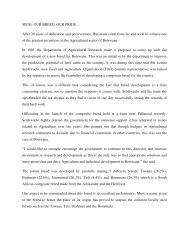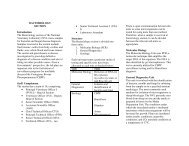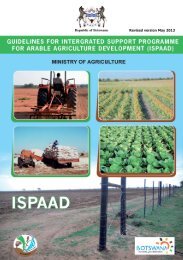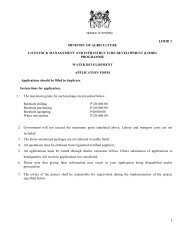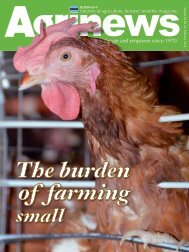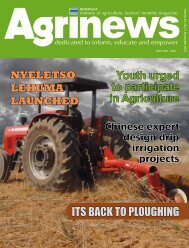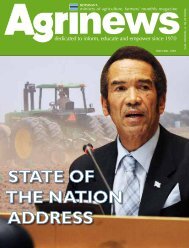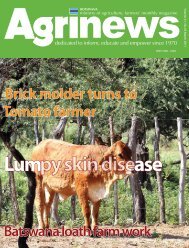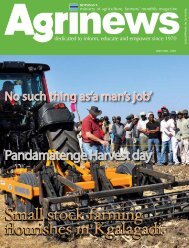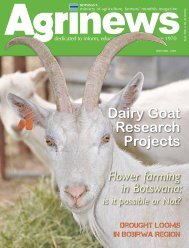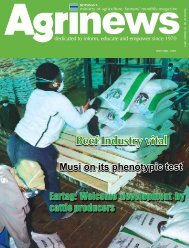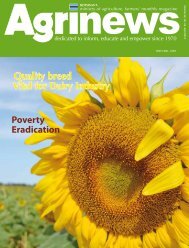Agrinews January 2013 - Ministry of Agriculture
Agrinews January 2013 - Ministry of Agriculture
Agrinews January 2013 - Ministry of Agriculture
You also want an ePaper? Increase the reach of your titles
YUMPU automatically turns print PDFs into web optimized ePapers that Google loves.
continued from page 15<br />
...both social and economically.<br />
All crops grown are suitable for fodder<br />
but not all farmers take notice <strong>of</strong><br />
that. Main crops such as graminae<br />
and leguminous family like Maize,<br />
sorghum, millet cowpeas, groundnuts,<br />
jugobeans, are widely grown in<br />
country but it is common that after<br />
grain harvest the whole Stover products<br />
is left standing in the fields and utilized<br />
by cattle and untimely. Farmers should<br />
be encouraged to take an advantage<br />
<strong>of</strong> making hay out <strong>of</strong> that to avoid<br />
starvation during dry season and fetch<br />
more cash.<br />
To cut failed crops while still green and<br />
dry them without losing green color<br />
indicates valuable nutrition then can<br />
be chaffed and sacked, or bailed to<br />
feed livestock during dry seasons will<br />
be an advantage.<br />
Growing the recommended fodder<br />
species is very vital for:-<br />
• Drought resistance<br />
• Tolerance to most soils <strong>of</strong> Botswana<br />
Question<br />
&<br />
During growing seasons, and in an<br />
event <strong>of</strong> poor crop performance and low<br />
germination percentage, the contributing<br />
factors are in most cases according to<br />
traditional farmers, lack <strong>of</strong> soil moisture<br />
content and poor quality seeds. But<br />
the fact <strong>of</strong> the matter is that there are<br />
many contributing factors such as Soil<br />
compaction which farmers may not<br />
be aware <strong>of</strong>. <strong>Agrinews</strong> reporter Joseph<br />
Ramodisa is having a conversation<br />
with Dr Flora Pule-Meulenberg, from<br />
the Department <strong>of</strong> Crop Science and<br />
Production at Botswana College <strong>of</strong><br />
<strong>Agriculture</strong> about soil compaction.<br />
Q. What is Soil Compaction?<br />
A. According to the Soil Science Society<br />
<strong>of</strong> America (1996), soil compaction<br />
is “the process by which soil grains<br />
are rearranged to decrease void space<br />
and bring them into closer contact<br />
with one another, thereby increasing<br />
the bulk density”.In very simple terms,<br />
soil compaction is the destruction <strong>of</strong><br />
the physical characteristics <strong>of</strong> a soil or<br />
the physical degradation <strong>of</strong> the soil.In<br />
soil compaction, the first property <strong>of</strong><br />
the soil to be destroyed is its structure.<br />
Soil structure refers to the spatial<br />
arrangement <strong>of</strong> the soil constituents<br />
and aggregates. Once the structure is<br />
destroyed, the pore space deteriorates<br />
and hence the capacity <strong>of</strong> the soil to<br />
retain moisture as well as its ability<br />
to circulate air becomes limited. The<br />
type <strong>of</strong> pores that transports air and<br />
warmth around the soil pr<strong>of</strong>ile, (called<br />
macropores) are the same ones that<br />
make it possible for water infiltration, be<br />
• Ability to spread naturally<br />
• Vigor <strong>of</strong> growth and growth rhythm<br />
fully expanded leaves developed<br />
at the rate <strong>of</strong> every nine to ten days<br />
in summer 11days in spring and 14<br />
to 12 in autumn with senescence<br />
highest in the summer growing<br />
seasons and slowest (Wilson &t<br />
Mannetje 1978)<br />
• Suitable for hay and silage the<br />
grass makes reasonable quality hay<br />
when cut in the early flowering<br />
stage, yielding up to 2500kg/ha<br />
per cut with a protein content<br />
<strong>of</strong> 6-10 percent <strong>of</strong> dry matter.<br />
Old grass, after the seed has<br />
harvested, can give low-quality<br />
roughage for drought feeding with<br />
supplements. This old grass will<br />
have protein content <strong>of</strong> 4-6 percent<br />
(Shankarnarayan 1977) while a<br />
mature animal require 7% protein<br />
for maintenance for survival.<br />
The grasses are economic hence are<br />
best forage grasses found natural in<br />
semi-arid, subtropical and tropics<br />
areas, and Botswana is the exemplary<br />
grasses habitat <strong>of</strong> many species.<br />
To make hay from the grass is convenient<br />
and save starting from December to<br />
March when grass nutrients is high and<br />
when there is plenty <strong>of</strong> sunshine.<br />
Tools required - Framing box (form)<br />
Scythe, Rake, Wire or string.<br />
Cut the grass in the morning with<br />
a sharp scythe when half <strong>of</strong> it has<br />
flowered. Make sure the grass is spread<br />
by tuning it once using a rake and leave<br />
it overnight for it to dry smoothly.<br />
Start bailing the dried grass the second<br />
day after cutting, by fill the dried grass<br />
in box with dimensions <strong>of</strong> 90cm length,<br />
60cm width and 60cm depth and pack<br />
it tightly in the box by trampling on<br />
many times then tie compacted grass<br />
with wire or string lift the box to<br />
release the bale if well packed is about<br />
15kg and it estimated that 2 men can<br />
make 60 bales day. (APRRD www.dar.<br />
gov.bw)<br />
Answer: SOIL COMPACTION<br />
it from rainfall or irrigation. Therefore, a<br />
compacted soil will likely have problems<br />
<strong>of</strong> water erosion due to increased<br />
surface run<strong>of</strong>f. The physical degradation<br />
<strong>of</strong> the soil will lead to the deterioration<br />
<strong>of</strong> some chemical properties. Because<br />
compacted soils do not have much<br />
air circulation, microorganisms that<br />
are responsible for organic matter<br />
decomposition and other important soil<br />
processes cannot survive. This leads to<br />
poor fertility <strong>of</strong> soils since organic matter<br />
is an important source <strong>of</strong> nutrients such<br />
as NPS. Another consequence <strong>of</strong> that<br />
scenario is that only anaerobic microbes<br />
will thrive, resulting in conditions<br />
that promote toxically high levels <strong>of</strong><br />
micronutrients (iron, zinc, manganese<br />
and copper) for plant growth. Ultimately<br />
for arable systems, soil compaction<br />
will lead to yield reduction through<br />
limiting fertility including interferences<br />
with moisture and nutrients.<br />
Q. Where Does It Occur?<br />
A. Soil compaction can occur in<br />
natural ecosystems as a result <strong>of</strong> animals<br />
trampling on wet soils, for example<br />
at watering points, human beings<br />
through construction (building, roads,<br />
pavements etc). For arable agriculture,<br />
compaction is caused by vehicles<br />
such as tractors, cars and their use at a<br />
particular moisture content.Ploughing<br />
or tilling a soil continuously with a<br />
mouldboard can lead to a compacted<br />
layer below the tillage depth in soils<br />
that are high in clay content. Soils<br />
that are high in clay content and<br />
low in organic matter compact very<br />
easily. For arable soils, as a rule <strong>of</strong><br />
to be continued in the next issue<br />
thumb, the heavier the equipment used,<br />
the higher the level <strong>of</strong> compaction.<br />
Q. To minimize soil compaction what<br />
should farmers do?<br />
A. There are several ways in which<br />
farmers could limit soil compaction.<br />
Tilling wet soils should be avoided<br />
at all times. This leads to formation <strong>of</strong><br />
puddles (seretse!) and when they dry<br />
they form clods (magwete!) that are<br />
hard for seedling to break through.<br />
Compaction has also been shown to<br />
increase with vehicle weight. Especially<br />
for commercial farmers, increasing tyre<br />
size has been shown to not compensate<br />
for increased axle load and it spreads<br />
compaction over a greater volume<br />
<strong>of</strong> the soil. It is a good practice not to<br />
carry very large loads on wet soils and<br />
to maintain proper tyre pressure. If it<br />
is necessary to drive on wet soil, it is<br />
better to stay on the same tracks to avoid<br />
compacting a larger area or volume <strong>of</strong><br />
soil. Regarding the use <strong>of</strong> a mouldboard<br />
plough, formation <strong>of</strong> a plough pan<br />
(compacted layer) will lead to decreased<br />
water percolation to the subsoil and<br />
may be avoided by deep ripping the<br />
soil once every four to five years.<br />
Q. What are the potential concerns<br />
about soil compaction?<br />
A. In summary, the main concerns about<br />
soil compaction include loss <strong>of</strong> moisture<br />
holding capacity, decreased rooting<br />
zone, loss <strong>of</strong> C, N, and P sources, changes<br />
in soil pH, changes in soil bulk density<br />
and increased erosion due to increased<br />
run<strong>of</strong>f as a result <strong>of</strong> limited infiltration.<br />
Kakamane educational tour - Serowe<br />
Article & Photos: Felix Mothatego<br />
Agricultural specialists, interested<br />
parties and farmers from Serowe<br />
village and surrounding areas<br />
discussed modern farming technology<br />
during educational tour at Kakamane<br />
fields, recently.<br />
The Department <strong>of</strong> Crop Production<br />
organized this event which attracted<br />
incredible people out there. We were<br />
blown away by level <strong>of</strong> commitment<br />
and community we found along the way.<br />
Small scale farmers appreciated that<br />
nowadays ploughing is mechanized,<br />
and tractor ploughs as much as<br />
30 times as a man with donkeys.<br />
They also saw reality <strong>of</strong> what goes on<br />
at sustainable small farms, and the<br />
need to better connect as farmers.<br />
The agricultural demonstrator,<br />
Gaopotlake Gabalebatse said they<br />
focused on the use and maintenance <strong>of</strong><br />
tractor/farming implements, seed bed<br />
preparation, and fertilizer application.<br />
He said farmers are not producing<br />
enough yields because they do not<br />
use modern technology. Some have<br />
agricultural implements but lack<br />
information and experience.<br />
As such, they encouraged farmers to<br />
exchange information and get assistance<br />
from demonstrators.<br />
“I think you have seen that most <strong>of</strong> them<br />
do not know how to calibrate a planter.”<br />
One <strong>of</strong> the farmers, Rasebolai Kgamane<br />
said he has implements but does not<br />
know how to use them.<br />
He said he is happy to have got<br />
information on plant population, use <strong>of</strong><br />
a planter and fertilizer application.<br />
The host farmer, Keataretse Monamo<br />
said she will improve her knowledge<br />
by being present when a tractor<br />
operator is ploughing and sowing.<br />
She has learnt a lot about<br />
moisture conservation, use<br />
<strong>of</strong> fertilizer and pesticides.<br />
She challenged fellow farmers who have<br />
not been using modern technology to try it.<br />
For his part, Baitirele Mothaleemang said<br />
it is unfortunate that even government<br />
tractors ploughing for farmers do not<br />
come with all necessary implements.<br />
He said as a consequence. farmers<br />
prefer broadcasting seeds because they<br />
want to sow before moisture evaporates.<br />
Unlike many farmers, Mothaleemang<br />
will be on his third year row planting<br />
and has been happy with harvest since<br />
he started it.<br />
This event was undoubtedly important<br />
because it helped small scale farmers<br />
and general public realize there is so<br />
much out there on how to produce<br />
food.<br />
<strong>January</strong> <strong>2013</strong> <strong>January</strong> <strong>2013</strong><br />
17



